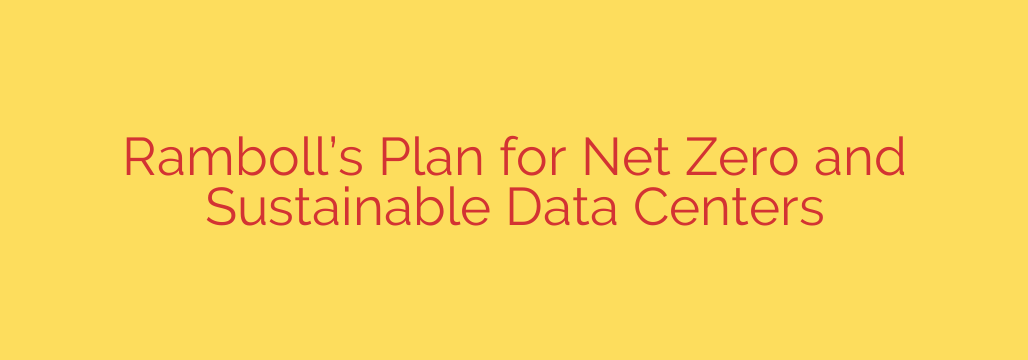
Building the Future: A Blueprint for Net-Zero Data Centers
Our world runs on data. From cloud computing and artificial intelligence to the daily hum of global business, data centers form the invisible backbone of our digital lives. Yet, this digital infrastructure comes with a significant physical footprint, consuming an estimated 1-2% of the world’s electricity. As demand for data skyrockets, the challenge is clear: how do we power our future without compromising the health of our planet?
The answer lies in a fundamental shift towards sustainable, net-zero data centers. This isn’t just about offsetting carbon; it’s about reimagining how these critical facilities are designed, built, and operated from the ground up. Moving forward requires a holistic, lifecycle-based approach that integrates energy efficiency, renewable power, and circular economy principles.
Beyond Efficiency: A New Design Philosophy
For years, the key metric for data center efficiency has been Power Usage Effectiveness (PUE), a ratio that compares a facility’s total power consumption to the energy used by its IT equipment. While aiming for a low PUE is important, it’s only one piece of the puzzle.
True sustainability demands a broader perspective. The path to net-zero begins at the earliest design stages, considering every element from the construction materials to the local climate. The goal is to create facilities that are not just efficient in operation but also low-impact in their very existence. This means evaluating the embodied carbon in concrete and steel, optimizing layouts for natural cooling, and designing for long-term adaptability.
Key Pillars of the Sustainable Data Center
Achieving a net-zero future for data centers hinges on a multi-faceted strategy that addresses energy, materials, and waste simultaneously.
1. Harnessing Renewable Energy Sources
The most crucial step is transitioning away from fossil fuels. This can be achieved through a combination of on-site generation, like solar panels on rooftops and surrounding land, and long-term Power Purchase Agreements (PPAs) with off-site wind and solar farms. Securing a 100% renewable energy supply is the cornerstone of any credible net-zero claim. Site selection is critical, prioritizing locations with abundant renewable resources and stable grids capable of supporting them.
2. Transforming Waste Heat into a Valuable Resource
Data centers are, in essence, enormous heaters. Traditionally, this vast amount of thermal energy is simply vented into the atmosphere as waste. However, a forward-thinking approach sees this heat as a commodity. By integrating heat recovery systems, a data center can capture its waste heat and use it to warm nearby homes, offices, or even greenhouses through a district heating network. This innovative strategy turns an operational liability into a community asset, dramatically improving the facility’s overall environmental performance.
3. Implementing a Circular Economy for IT Hardware
The lifecycle of servers, racks, and cooling units contributes significantly to a data center’s environmental impact. A circular economy model challenges the traditional “use and discard” approach. This involves:
- Designing for disassembly to make repairs and upgrades easier.
- Prioritizing refurbishment and reuse of servers and components to extend their lifespan.
- Establishing responsible recycling programs to recover precious materials from end-of-life equipment.
By minimizing e-waste and reducing the demand for new raw materials, the circular economy is essential for long-term sustainability.
4. Sustainable Construction and Water Use
The carbon footprint of a data center begins long before the first server is switched on. Using low-carbon building materials, such as green concrete and recycled steel, is essential to minimizing embodied carbon. Furthermore, many traditional cooling systems consume massive quantities of water. Sustainable designs prioritize closed-loop cooling systems or take advantage of naturally cool climates to reduce or even eliminate water consumption, protecting local water resources.
Actionable Steps Toward a Greener Digital Infrastructure
For operators, investors, and developers in the data center industry, the path forward is clear. Building a sustainable facility isn’t just an environmental responsibility—it’s a business imperative that enhances brand reputation and resilience.
- Integrate Sustainability from Day One: Make net-zero goals a core part of the initial site selection and design process, not an afterthought.
- Prioritize Heat Reuse: When evaluating potential sites, analyze the proximity to urban or industrial areas that could benefit from a district heating system.
- Demand Supply Chain Transparency: Work with vendors who are committed to the circular economy and can provide documentation on the lifecycle of their equipment.
- Look Beyond PUE: Measure and report on a wider range of metrics, including carbon usage effectiveness (CUE), water usage effectiveness (WUE), and the percentage of renewable energy used.
The data centers of the future will be more than just powerful—they will be intelligent, efficient, and fully integrated into the sustainable ecosystems around them. By adopting this comprehensive blueprint, we can ensure that our digital growth continues to drive human progress without costing the earth.
Source: https://datacenternews.asia/story/ramboll-sets-roadmap-for-net-zero-sustainable-data-centres








